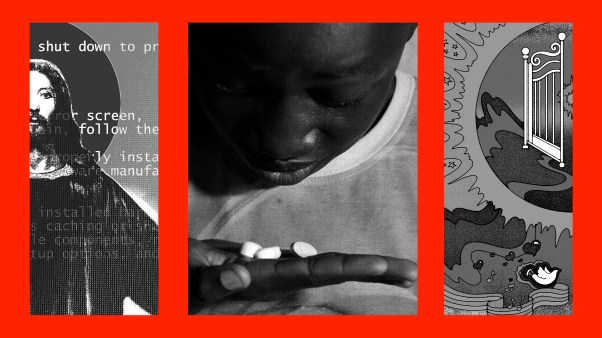There are two Marys. One wears a Carolina blue robe, exudes piety from a somber face, often holds her baby son in her arms, and barely makes eye contact with us. This is the familiar Blessed Virgin Mary, and she leads us to a Christmas celebration of quiet reflection.
Another Mary—the Blessed Valorous Mary—wears ordinary clothing and exudes hope from a confident face. This Mary utters poetry fit for a political rally, goes toe-to-toe with Herod the Great, musters her motherliness to reprimand her Messiah-son for dallying at the temple, follows her faith to ask him to address a flagging wine supply at a wedding, and then finds the feistiness to take her children to Capernaum to rescue Jesus from death threats. This Mary followed Jesus all the way to the Cross—not just as a mother, but as a disciple, even after his closest followers deserted him. She leads us to a Christmas marked by a yearning for justice and the courage to fight for it. Like other women of her time, she may have worn a robe and a veil, but I suspect her sleeves were rolled up and her veil askew more often than not.
Instead of asking what the real Mary was like, we tend to debate what she was not: whether she and Joseph refrained from sexual relations and whether she had a sin nature. A cursory reading of Jaroslav Pelikan's brilliant Mary Through the Centuries will acquaint any reader with the fulsomeness of such debates. Because Protestants have spent their time debating about Mary, they have rarely attempted to claim her as their own. Consequently, she has become little more than a delicate piece in a Christmas crèche, whom we bring out without comment at Christmas and then wrap up gently until we see her again next Advent.
But there are signs that those days are coming to an end. On the horizon today is nothing less than a Protestant reclamation of Mary, seen most completely in Tim Perry's new book, Mary for Evangelicals(InterVarsity, 2006). For the purposes of this article, we first need to ask, "Which Mary?" A good place to begin our search for answers is Mary's Magnificat. There we will discover not so much the Blessed Virgin Mary draped in piety, but the Blessed Valorous Mary dressed for action.
Subversive
If we read the Magnificat as the heartfelt release of a woman yearning for what God was—finally!—about to do in Israel and in historical context, we see it as a call to subvert unjust leaders. To turn this song into simple spirituality strips it of its meaning and leaves injustices—personified by Caesar Augustus and Herod the Great—on the throne.
Luke tells us that as soon as the angel Gabriel left Mary, she hurried down to the home of her older relative, Elizabeth, to share the Good News. Mary knew that aging Elizabeth would also, by God's grace, give birth to a special son. As New Testament scholar R. T. France has noted so poetically, "One is old and has no children; the other is young and has no husband. But both are pregnant." And both are ready to announce the Good News to the world.
The moment Mary crosses the threshold of Elizabeth's home, the formerly barren woman bursts into a poetic blessing for Mary. Mary echoes back with what God is doing in her womb: "My soul glorifies the Lord, and my spirit rejoices in God my Savior."
Mary rejoices over what Gabriel has told her and what Elizabeth has confirmed: Her son is the Son of David, the Messiah and future king. She exults that God is about to establish justice by ushering in the kingdom that all of Israel, especially the poor, have yearned for. Yes, like Hannah of old, she is happy that she will be a mother. Yes, she is happy that God has "been mindful of the humble state of his servant. From now on all generations will call me blessed, for the Mighty One has done great things for me—holy is his name" (Luke 1:46-49).
But her next words move beyond the personal exultation of a poor, pregnant woman. They are a declaration—on the order of Luther pinning his 95 theses to the door—from a voice at the bottom of society. It is a voice crying from the depths that God's Messiah was finally bringing justice for the poor (such as Mary, Simeon, and Anna). It is a voice proclaiming a new order—an order centered on her son, the One who would save his people from their sins (Matt. 1:21).
If we want to enter the world of the real Mary that first Christmas, listen once again to her song in the context of Herod the Great. Herod, we might recall, had assassinated members of his own family for anything that even smelled of treachery. That same Herod had taxed Israel—felt more by the poor than by anyone else—beyond its means. Hear her words in that context. They are words of subversion, words that reveal why unjust rulers might worry over their public recitation, words that tell the first Christmas story:
His mercy extends to those who fear him,
from generation to generation.
He has performed mighty deeds with his arm;
he has scattered those who are proud in their inmost thoughts.
He has brought down rulers from their thrones
but has lifted up the humble.
He has filled the hungry with good things
but has sent the rich away empty.
He has helped his servant Israel,
remembering to be merciful
to Abraham and his descendants forever,
just as he promised our ancestors (Luke 1:50-55).
When Mary announced that God "has brought down rulers from their thrones," anyone within earshot knew what that meant for Herod the Great, if not also for Rome. And, in noting that God "sent the rich away empty," she pointed her finger at Herod the Great with his insatiable appetite. God "has lifted up the humble" and "has filled the hungry with good things" meant that Mary and the poor of Israel would experience justice.
Had Mary sung this song—and probably she sang it more than once—in Nazareth among the peasants of Israel, they would have hoisted a toast and shouted, "It's about time! Blessed be the Lord (and Mary)!"
I recall sitting in my high school gymnasium in 1970. During an all-school assembly, African American students, wearing black, sang "Black is Beautiful" and "We Shall Overcome." Their steely protest, expressed in song, was more than a concert. It was an announcement, much like the Magnificat, that a new day had dawned and that justice was about to roll down our hallways. Mary's Magnificat, like those songs of change, can be seen as a rally cry, a revival song. It subverted the unjust reign of Herod the Great.
If you were a poor woman in the first century, if you were hungry, if you had experienced the injustices of Herod, and if you stood up in Jerusalem and announced that God would yank down the proud, the rulers, and the rich from their high places, you likely would be tried for subversion. If you were Herod or one of his ten wives or one of his many sons or daughters with (unexpressed, of course) hopes for the throne, you would conclude that Mary was a rebel, a revolutionary, a social protester. And you would be right: The real Mary was a subversive.
We can quietly repeat the Magnificat during evening prayers, or we can stand with Mary, sing it full throttle, and declare that justice ultimately will be established. The Herods of this world will be dethroned because Mary's son, the newly conceived Son of David, has gained a foothold in our world. Herod dethroned and Jesus enthroned was Mary's rallying cry. You can paint the Blessed Virgin Mary as tender and a splendid example of spirituality, or you can celebrate the Blessed Valorous Mary, who heralded a socio-religious protest against injustice in the person of her own Messiah-son.
But there is much more to Mary's song than justice for the poor. Like the rest of those who followed Jesus, Mary would learn that Jesus ushered in a new kingdom not by wearing Herod's crown but by dying on a Cross, rising from the dead, and sending the Spirit. This is first hinted at by Simeon, when Jesus was presented in the temple: "This child is destined to cause the falling and rising of many in Israel, and to be a sign that will be spoken against, so that the thoughts of many hearts will be revealed," he said. "And a sword will pierce your own soul too."
The hope for a political Messiah, as natural as it was for a people suffering under Roman oppression, would itself be subverted by an altogether different kind of Messiah—one who would establish justice by dying and rising for the forgiveness of sins. Justice for the poor would come not through political revolution but through God's kingdom and its vision for a new society, embodied in the church.
But the larger point remains: Mary, before anyone else, sees and announces the radical nature of Jesus' mission.
Dangerous
Subversive Mary was also dangerous—both to the powers that be and to anyone connected with her, especially Joseph and Jesus. To use today's parlance, we might say that Mary was "radioactive." We need only think of Herod wanting to know where Jesus was born so he could murder him—or of Herod's subsequent slaughter of the innocents. But Mary seemed unfazed.
"Nice girls," Lynne Hybels of Willow Creek Community Church writes, "don't change the world." It may seem counterintuitive, but Mary was not a "nice" girl. If "nice" means meek and mild and mind-your-own-business, then Mary scared the saintly piety out of nice girls. Mary minded Herod's business and, as we are about to see, Caesar Augustus', too. (She would later mind Jesus' business, before discovering that his business was his Father's business. But that's getting ahead of ourselves.)
"And it came to pass in those days," the King James Version of Luke 2:1 reads, "that there went out a decree from Caesar Augustus, that all the world should be taxed." There is a reason why Luke tells us that Jesus' birth occurred during the reign of Caesar Augustus. Luke is contrasting the gospel of Rome with the gospel of Jesus.
Rome's gospel told of the significance of Caesar Augustus for the world. Rome's history took a new turn with Augustus, the adopted son of the dictator Julius Caesar. After his death, Julius Caesar was officially declared to be a god. When Augustus seized power, he was deemed a savior because he ended bitter civil wars and created the peace of Rome (pax Romana). The gospel of Rome was that Augustus, a "son of [a] god," saved Rome by bringing peace to the world.
Luke's Christmas story, told largely through the eyes of Mary, sets the birth of Christ in the context of the gospel of Rome. Luke counters and upstages each element in Rome's gospel—Good News, peace, the Son of God, and the Savior. The gospel that angels announced to Mary and the shepherds was the Good News that Jesus, the Son of God, was the Savior who would bring true peace to the world.
Gabriel tells Mary that the "holy one to be born will be called the Son of God" (Luke 1:35). Nine months later, angels tell the shepherds outside Bethlehem, "Do not be afraid. I bring you good news of great joy that will be for all the people" (Luke 2:10). Jesus, the Son of God, is the Good News for his people. Furthermore, the angel says, "Today in the town of David, a Savior has been born to you; he is the Messiah, the Lord" (Luke 2:11). And then we hear a chorus of angels: "Glory to God in the highest heaven, and on earth peace to those on whom his favor rests" (Luke 2:14).
Caesar Augustus supposedly was a savior, a son of a god who brought good news of peace to the world. Luke tells his readers that Jesus is the real Son of God, the Savior, who brings Good News of peace to the world. Not only do we have a tale of two Marys; we have a tale of two kings. Who, we are led to ask, will be the king? As with the Magnificat, so with Luke's story: Augustus dethroned, Jesus enthroned!
Mary in the Middle
Mary was in the middle of both of the angelic announcements. Gabriel appeared to Mary and, when the angels spoke to the shepherds, the shepherds reported their Good News to Mary and Joseph. Mary had a dangerous story to tell that would subvert injustice and establish justice through her son, the Messiah of Israel.
Luke says that Mary "treasured up all these things and pondered them in her heart" (Luke 2:19). The traditional take on Mary's pondering is that she quietly reflected, perhaps in a corner when everyone else was dancing and clapping, and then humbly kept everything inside. But in Scripture, the word ponder denotes observing and thinking and then interpreting (Gen. 37:11; Dan. 7:28). The language of pondering refers to Mary's deliberating in order to comprehend the divine plan now at work.
Mary was a subversive and she was dangerous, first, because she knew the identity of her son and, second, because she began to tell his story. Remember, Gabriel told Mary her son would be "Jesus" (Savior) and "Son of the Most High God" and that he would sit as a Davidic king on the eternal throne. At the bottom of the entire history of Christology are the titles and categories given to Mary to pass on to others. God first tells her the true identity of Jesus. Thus, we first learn to see who Jesus was and is through her witness. Mary was the only person in the world who could have told the stories that now appear in our Gospels. She alone heard the potent words of Gabriel; she alone was with Elizabeth; perhaps she is the one who told Luke about Zechariah's song; only she and Joseph knew about the shepherds and the magi.
Like Harriet Beecher Stowe, who wrote Uncle Tom's Cabinto reveal the injustice of slavery, or Harper Lee, whose To Kill a Mockingbirdrevealed the insidiousness of racial hypocrisy, Mary also had a (true) story to tell about her son. She took the terms Gabriel gave her—Son of God, Savior, Messiah—and began to interpret who he was and what he was to do.
The Gospels come from many voices, and one of those was Mary's. Her voice tells us what God would do through her son to subvert the injustices of Herod and the pretentiousness of Augustus. Her voice tells us that somehow, some way, someday, God would establish a kingdom of peace for the whole world. The real Mary, in the story rarely told, changed the world by surrendering to the angel Gabriel with three words: "May it be." And God used her to set loose the power of God, the gospel of the kingdom. This is the real Mary, and we need to reclaim her voice as our own.
Scot McKnight is the Karl A. Olsson professor in religious studies at North Park University, Chicago. This article is adapted from The Real Mary: Why Evangelical Christians Can Embrace the Mother of Jesus (Paraclete, 2006).
Copyright © 2006 Christianity Today. Click for reprint information.
Related Elsewhere:
The Real Mary: Why Evangelical Christians Can Embrace the Mother of Jesus by Scot McKnight is available from Christianbook.com and other retailers.
Scot McKnight's blog, "Jesus Creed" has several posts on Mary. His older blogs include "Divine Hours Daily Blog" and "Jesus and His Death."
Paraclete Press has more information on The Real Mary, including a sample chapter.
Other Christianity Today articles on Mary include:
The Blessed Evangelical Mary | Why we shouldn't ignore her any longer. (December 1, 2003)
The 'Assumed' Fate of Jesus' Mother | Roman Catholics celebrate the Feast of the Assumption on Sunday. What's "up" with that? (Aug. 13, 2004)
The Serene Contradiction of the Mother of Jesus | Why I reclaimed the virgin mother as a significant figure in my faith (December 1, 2002)
There's Something About Mary | Beliefs about Jesus' virgin mother vary between Christians of the early church, Roman Catholics, and modern-day Protestants, but this model of total trustful devotion has lessons to teach all Christians. (December 1, 2002)
His Mother | Learning from Mary, the maternal model. (May 12, 2000)
Christian History and Biography Issue 83 includes Mary in the Imagination of the Church, Recovering a Protestant Mary, and several other articles on Mary.
Christianity Today Movies has a special section for The Nativity Story, which releases into theaters December 1.










